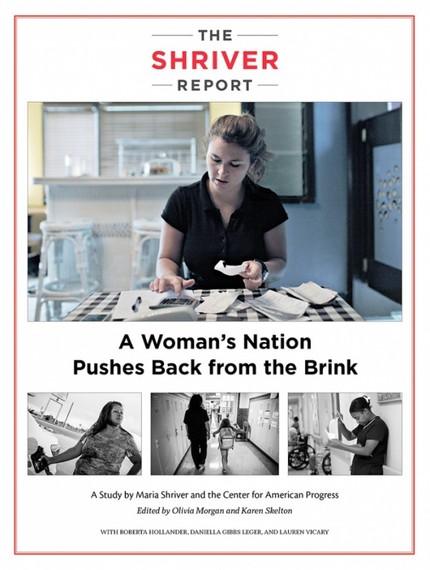In this country, women are half of the U.S. workforce, most of our college graduates, the vast majority of consumer spenders, and more than half of the nation's voters. But one in three American women are poor. Women are nearly two-thirds of minimum-wage workers. Women earn 77 percent of a man doing the same job. Whip lash? For sure.
It's this America in crisis that "The Shriver Report: A Woman's Nation Pushes Back from the Brink" reveals and reports on. A partnership between Maria Shriver and the Center for American Progress, this in-depth examination of the status of the American women, released today, is the culmination of a three-volume analysis begun in 2009 when Maria was California's First Lady.
At that time, Maria was hosting the "Women's Conference," the premier gathering of women in the world. It featured world leaders alongside women working on the front lines -- a place where Davos met Main Street. My job as an executive producer of the conference led to my becoming the editor-in-chief of The Shriver Report, because it quickly became obvious to Maria and our team that women at the conferences were facing a new array of challenges in a radically transformed social environment.
America had become a Woman's Nation but hadn't adapted to what that means. That insight from the conference inspired a more expansive examination of the status of the American woman and our groundbreaking reports were born. The Shriver Reports catalogue transformational moments in American culture that impact women and families.
In 2009, "The Shriver Report: A Woman's Nation Changes Everything" explored the national impact of women becoming half the workforce for the first time. In 2010, "The Shriver Report: A Woman's Nation Takes on Alzheimer's" used the lens of Alzheimer's disease to focus on women not only as the majority of people who have the disease but also the majority of unpaid caregivers in this country.
Each Shriver Report ignited a national conversation and sparked wide media coverage, including Time cover stories and a special week of broadcasts by ABC and NBC News. The Shriver Reports have spurred Congressional hearings, White House studies and pilot projects, and most important, the passage of historic legislation. This year, HBO made a documentary, Paycheck to Paycheck: the Life and Times of Katrina Gilbert, airing on March 17, which brings to life in film the women we report on.
While the first Shriver Report focused on women in their careers and the second focused on women as caregivers, the third Shriver Report centers on the damage that occurs when a nation doesn't support or respect these dual roles. That lack of support is a leading cause of our current national economic crisis -- and chronically under-reported by the media.
The most common shared story in the United States is the financial insecurity of American families. Economic immobility and inequality is such a systemic and pervasive problem that President Barack Obama recently described it as "the defining challenge of our time." Yet, rarely are women even mentioned.
"The Shriver Report: A Woman's Nation Pushes Back From the Brink" focuses on this national crisis and its impact on women. Today in America, 42 million women and the 28 million children who depend on them are poor or teetering on the edge of poverty, barely scrapping by in a space we call "the brink."
At its core, this Shriver Report calls on the nation to modernize its relationship to women. Failing to adapt to the Woman's Nation that actually exists in America, only further weaken our economy and our families.
